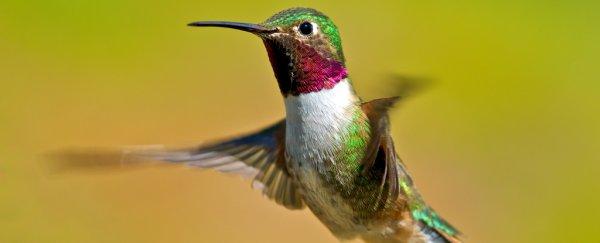Hummingbirds can perceive colours that the human eye cannot, thanks to the addition of an extra cone in the hummingbird's eye that we don't possess, new research reveals.
The findings, demonstrated in experiments with wild broad-tailed hummingbirds (Selasphorus platycercus) in Colorado, suggest that the ability to discriminate non-spectral colours (including ultraviolet wavelengths) could play a vital role in behaviours including mating, feeding, and evading predators.
Unlike humans, who have three kinds of colour-sensitive cone cells in our eyes, birds have four types of cone cells that help them to process the differences between different kinds of colours. With three cones, human eyes can perceive what's known as trichromatic colour, made up from a neural blend of red, green, and blue light.
Thanks to that process, our brains can perceive the non-spectral colour purple (because it's a combination of blue and red). But animals with an extra cone can see an even greater spectrum of colours by being sensitive to more kinds of light wavelengths - opening the door to other kinds of colour combinations that we can't see or even… imagine.
"Humans are colour-blind compared to birds and many other animals," says evolutionary biologist Mary Caswell Stoddard from Princeton University.
"Not only does having a fourth colour cone type extend the range of bird-visible colours into the UV, it potentially allows birds to perceive combination colours like ultraviolet+green and ultraviolet+red – but this has been hard to test."
It's thought that birds, with their extra cone cell, may be able to perceive as many as five non-spectral colours, including purple, ultraviolet+red, ultraviolet+green, ultraviolet+yellow, and ultraviolet+purple.
To test this, Caswell and her team set up 'bird vision' LED tubes programmed to display a number of colours, including the non-spectral colours that humans cannot see. These devices were then placed beside water-feeders, some of which contained sugar water (which the birds like) next to one colour, while others contained plain water next to a different colour.
They would then swap the positions of these feeders and see if the birds could use the colour indicator to tell which feeder was which.
In a series of randomised experiments over three years (involving thousands of feeding sessions), the goal was to see if the hummingbirds showed a preference to feed at the water stations displaying the ultraviolet colour combinations, which would support that they could see them, even if humans can't.
As it turns out, the animals could, easily distinguishing between the different kinds of non-spectral colours to obtain a sweet reward.
"It was amazing to watch," says study co-author and PhD student Harold Eyster from the University of British Columbia.
"The ultraviolet+green light and green light looked identical to us, but the hummingbirds kept correctly choosing the ultraviolet+green light associated with sugar water. Our experiments enabled us to get a sneak peek into what the world looks like to a hummingbird."
While we humans with our puny human eyes can't really understand what these colour variations look like to the animals, the results suggest there is a discernible difference - as far as birds are concerned - between ultraviolet, red, and ultraviolet+red, with the same going for ultraviolet+green, ultraviolet+yellow, and ultraviolet+purple.
We might not be able to see or understand it, but the hummingbird can.
In another experiment, the researchers analysed almost 1,000 different kinds of bird plumage, and almost 2,400 different kinds of plants, and found that the colours of about one-third of each would be perceived as a non-spectral colour – indicating just how much this visual ability could affect their interactions with the world.
"These results are consistent with the claim that birds are tetrachromats, such that the avian colour space represents a vast range of behaviourally and ecologically relevant colours, many of which humans (or any trichromat) cannot even imagine," the researchers explain in their paper.
"Showing that birds can discriminate a variety of non-spectral colours provides a step forward in our understanding of the dimensionality of bird vision."
There's still a lot to be learned here, with the researchers saying their results, impressive as they are, fall short of a proof that birds possess a tetrachromatic visual system.
In the future, more rigorous experiments with more colours could help us further test the limits of birds' colour perception. Even then, there's still much we don't know about what neural mechanisms enable the animals' brains to perceive these colours.
Not to mention, as the researchers say, the "more philosophical question of what non-spectral colours really look like" in the strange eyes of hummingbirds.
"Does UV+green appear to birds as a mix of those colours (analogous to a double-stop chord played by a violinist) or as a sublime new colour (analogous to a completely new tone unlike its components)? We cannot say," the authors write, noting that pondering this unanswerable question about unseeable colours is purely a human burden.
"Ultimately, what matters to a bird is probably not whether colourful signals are detected by adjacent or nonadjacent cone types: It is how those colours function to provide information about food, mates, or predators."
The findings are reported in PNAS.
